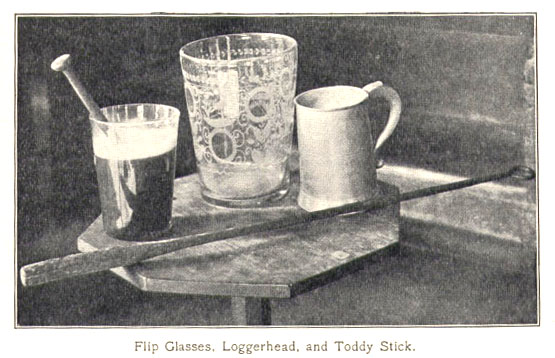In Colonial times, a mug of this was so valued that it cost three times a night’s lodging in a tavern. (Or maybe the lodging price was super-cheap, to bring in customers to buy the drinks?)
…Put the Ale on the Fire to warm, and beat up three or four Eggs with four ounces of moist Sugar, a teaspoonful of grated Nutmeg or Ginger, and a Quartern [a quarter of a gill or the equivalent of a “dash”] of good old Rum or Brandy. When the Ale is near to boil, put it into one pitcher, and the Rum and Eggs, etc., into another: turn it from one Pitcher to another till it is smooth as cream. To heat plunge in the red hot Logger-head or Poker. This quantity is styled One Yard of Flannel.
–from Stage-Coach and Tavern Days, by Alice Morse Earle, 1924
It is a certainty that every one of the Founders knew (and some no doubt loved) this beverage. George Washington’s expense account is filled with entries for it. It even had its own special glass:
Here’s a simpler recipe for a variation of the same thing:
A great pewter mug or earthen pitcher filled two-thirds full of strong beer; sweetened with sugar, molasses, or dried pumpkin, according to individual taste or capabilities; and flavored with `a dash’ -about a gill- of New England rum. Into this mixture a red hot loggerhead, made of iron and heated in the fire, was thrust.
The drink is flip, and it was to our forefathers what coffee is to us today. (Yes, I know they drank coffee back then too. Quiet, I’m trying to make a point.) Ms. Earle continues:
“Every tavern bill of the eighteenth century was punctuated with entries of flip. John Adams said that if you spent the evening in a tavern, you found it full of people drinking drams of flip, carousing, and swearing….” She quotes a poem:
Where dozed a fire of beechen logs that bred
Strange fancies in its embers golden-red,
And nursed the loggerhead, whose hissing dip,
Timed by wise instinct, creamed the bowl of flip.
–James Lowell.
The three chapters on Colonial alcoholic beverages are online here: Tavern Fare and Tavern Ways; Kill-Devil and Its Affines; and Small Drink.Â
Apparently the antique and junk shops on the East Coast of the United States are littered with old flip glasses and flip pitchers, some handsomely decorated. The loggerhead appears from the above photo to look like a railroad spike with a rounded head.
How’s it taste? Unfortunately, our Founders seem to have been made of sterner stuff than we. Ms. Earle herself, who wrote three entire chapters praising flip and other colonial beverages, admits that she brewed a mug of flip according to a Revolutionary general’s recipe, but discovered
“alas, I had neither the tastes nor the digestion of my Revolutionary sires, and the indescribable scorched and puckering bitterness of taste and pungency of smell of that rank compound which was flip, will serve for some time in my memory as an antidote for any overweening longing for the good old times.”
For more background on colonial beer-based mixtures, see this page (although about 90% of its discussion of flip, I must point out, is lifted directly from Ms. Earle’s book without attribution.)
I was lucky enough to find the 1924 printing of Ms. Earle’s little treatise in a used book shop in Boston about eighteen years ago. It’s also been reprinted, and if you’re at all the type who enjoys curling up by the fire while reading about the details of life in colonial days, search it out. It’s a treat.
Happily, you don’t have to go to all that trouble if you don’t want to: it’s been digitized. Ain’t the internet great!
Oh, and for everyone who can’t stomach real flip but still wants to play with fire and beer at the same time, see Tony’s site. It discusses modern loggerheading, including an analysis of the physics of it (the heat caramelizes the sugars in the beer). It even includes a a possible origin for the practice: Colonial drinkers didn’t want to drink cold beer on cold nights, so they’d plunge in the loggerhead to warm it up! Sounds plausible to me.



Hmmm, sounds like the origin of the phrase “ain’t worth a flip”.
It was another mulled drink. Since there were no microwave ovens then, the best way to heat such a drink without boiling off all the OTOH was to mull it, or put a hot poker into it.
The rum was added because it was the only cheap and available distilled spirit. Whisky was too expensive, gin was the province of the Dutch and almost unknown, and Vodka was also unknown here. You wouldn’t use spendy Benedictine Brandy for that purpose, either.
This drink evolved into the later drink, Needled Beer, necessary after the 19th Amendment passed and all but near-beer was banned. Pure grain spirits were added to the beer to put some kick back into it. I tried to make some as a youth, after hearing my Dad talk about it, but it was awful and undrinkable.
Hmmm… sounds as if some things in the past deserve to remain there. The combination of beer and eggs should set any modern stomach off, and loggerheading it would only scramble the eggs if you didn’t mix it just right.
Now, mulled mead, I can drink. Lots. Yummy. And it’s colonial! Well, it’s also midevil. Hell, it’s been around for centuries. But it’s still good.
I have to disagree with Ms. Earle and the rest, who think the drink will be bitter and/or curdled. Our ancestors weren’t stupid, nor did they “eat dirt and like it,” as my camping group used to say about a bad dinner.
Flip, when done properly, should be a rum-powered, hot and carmelly egg nog. May I suggest one try, try again, until the taste matches one’s expectations?